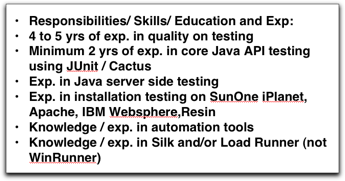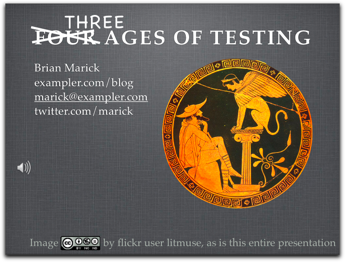Getting invited to speak (part 2)
You’re more likely to be invited to speak if you’re a good speaker. For the most part, I have the same advice you’ll find at places like Presentation Zen: avoid bullet points, etc. I have some idiosyncratic habits, though. They’re after the jump.
As with the previous entry, a disclaimer: the way I present is driven by my personality and background. I don’t claim any universal goodness for it.
I like to start the talk with a jolt, something odd and unexpected. That immediately captures the audience’s attention. It’s best if the oddity connects thematically with the talk or audience—otherwise it can feel lame and forced, like starting with a joke about three ducks walking into a bar.
 Perhaps my favorite beginning was for a talk called “Testing in Changing Times” at STAR. It began with no introduction, no one on stage, text from a job ad being projected word-by-word on the big screen, along with a stuttering version of the line “I am not a number, I am a free man!” from the weekly intro to the 60’s TV show The Prisoner. It ended with the whole line delivered clearly, followed—as it invariably was in the show—by howls of laughter in response.
Perhaps my favorite beginning was for a talk called “Testing in Changing Times” at STAR. It began with no introduction, no one on stage, text from a job ad being projected word-by-word on the big screen, along with a stuttering version of the line “I am not a number, I am a free man!” from the weekly intro to the 60’s TV show The Prisoner. It ended with the whole line delivered clearly, followed—as it invariably was in the show—by howls of laughter in response.
Most people in the audience didn’t get the reference, I’m sure, but that’s irrelevant. The point was to simultaneously disorient (”What’s going on?”) and orient around the phrase “I’m not a number”, which most people have heard.
 I then clicked through to the next slide, and started speaking in a soft-but-amplified voice—”you’re not a number… you’re a commodity”—while still not on stage. I was in the audience, where I could observe people’s reactions. It was interesting: as slides kept appearing and an empty stage kept talking, people started to get visibly more disturbed.
I then clicked through to the next slide, and started speaking in a soft-but-amplified voice—”you’re not a number… you’re a commodity”—while still not on stage. I was in the audience, where I could observe people’s reactions. It was interesting: as slides kept appearing and an empty stage kept talking, people started to get visibly more disturbed.
The thematic connection was that my talk was about how to avoid being treated as a commodity, and I kicked it off by evoking the discomfort of being treated as a commodity. (For all they knew, I pointed out, they could be listening to a recording.)
 A less elaborate example comes from a SPA talk. I began by showing the video “The Inner Life of a Cell“. After it was over, I asked how many people thought the complexity shown was chaotic and unappealing. To those who raised their hand, I said, “You’re going to hate this talk.” The thematic connection? The talk contrasted finding simple foundations and building on them (the approach of physics) with the approach of wallowing in complexity and exploiting regularities (the approach of biology).
A less elaborate example comes from a SPA talk. I began by showing the video “The Inner Life of a Cell“. After it was over, I asked how many people thought the complexity shown was chaotic and unappealing. To those who raised their hand, I said, “You’re going to hate this talk.” The thematic connection? The talk contrasted finding simple foundations and building on them (the approach of physics) with the approach of wallowing in complexity and exploiting regularities (the approach of biology).
 Other shock intros are less thematic than tactical. When I gave a talk at Google, my intro music was The Who’s “My Generation“, and I began by saying something like this:
Other shock intros are less thematic than tactical. When I gave a talk at Google, my intro music was The Who’s “My Generation“, and I began by saying something like this:
“About 25 years ago, I was a cocky young successful Unix programmer. I went to this talk by a guy from IBM. He was talking about software lessons from the IBM 360 or some such, and I remember thinking, ‘This guy is a dinosaur. He has nothing to say to me.
“And you know what? I was right.”—they laugh—”I’m keenly aware that I’m the dinosaur up on stage, and you’re the cocky young successful programmers thinking I have nothing to say…”
With an intro that contained a reversal of expectation—”I was right”—I established some affinity and bought myself time to hook a more-skeptical-than-average audience.
My other important habit is to make every talk be a stretch. If a proposal I’m making to Agile2009 is accepted, it will be the first time I’ve ever repeated a conference talk. (Even with that one, I have some substantial revisions planned.) I’ll often repeat some of my obsessions (like the physics/biology one, or Ward Cunningham’s story of Advancers), but they’re always in a new talk with a new overall message. (Often they’re on new slides, too.) I do that because a big reason I bother with talks is that I want to figure out what I really think about a topic by explaining it to someone else. By creating each talk afresh, I keep each talk… fresh. I avoid being one of those speakers who’s mechanically repeating something that’s become boring to him.
Another way I keep fresh is with stylistic innovation. For example, I recently experimented with a talk using Lessig Method: one word or simple image per slide, flipping through slides quickly (once every six seconds, in this case), close synchronization between speech and image. (Video here.) That worked well. Most of the innovation is smaller scale than that.
The rest of the points are fairly minor:
-
I practice talks a lot, certainly once a day for the three days preceding the talk, ending with a practice run the morning of the talk. I invariably change the slides with each dry run. In at least one case, the talk really came together on the last dry run (many changes to slides).
The point of practicing isn’t to memorize the words, though I will use roughly the same words in the real talk as in the last dry run. It’s to be so familiar with each slide that I can vary how I say its message to match how the audience seems to be responding, and also so that I can ad-lib easily.
-
Words and images on the slides are mostly there to remind me of what to say. You can’t make any sense out of my slides without the sound track.
-
 Because my talk tends to contain high-falutin’ pseudo-intellectual or intellectual content, I buy back a little credibility with plainness. I’ll speak with casual language, even exaggeratedly so (as with “high-falutin’”). The slide background is plain—no decoration for its own sake, no reminders of who I am on each page. I usually use a blackboard theme with a font modeled after handwriting (Apple’s “chalkboard” theme with the “blackboard” font.) I make heavy use of crude line drawings.
Because my talk tends to contain high-falutin’ pseudo-intellectual or intellectual content, I buy back a little credibility with plainness. I’ll speak with casual language, even exaggeratedly so (as with “high-falutin’”). The slide background is plain—no decoration for its own sake, no reminders of who I am on each page. I usually use a blackboard theme with a font modeled after handwriting (Apple’s “chalkboard” theme with the “blackboard” font.) I make heavy use of crude line drawings. -
I think audiences pay attention better if you keep their eyes moving. One of the advantages of Lessig Method is that what they’re looking at is constantly changing. Animations and progressive builds do the same thing, so I use them a lot. I avoid trite animations and favor ones that illustrate what I’m talking about at the moment. Here’s an example (click to play):
In addition to the animations, this clip shows me using crude drawings to contrast with high-brow concepts, and how I quickly move from offputting sociology-talk (”class? racism?”) to a project scenario.
I also tend to move around the stage. Even though it annoys some people, it gives everyone’s eyes something to follow.
-
I try to have the whole presentation follow a single “arc”. I avoid breaks in the momentum where I change topic. I like each slide to build on (add something to, refer back to) the previous slide.
-
In addition to thinking of the whole presentation as having a narrative arc like a typical story or novel, I tell stories inside the presentation. People like to hear relevant stories. (But I have an inherited propensity to ramble, so it’s important for me to think consciously about making every sentence relevant: either it adds a necessary fact to the story or it’s to provoke or set up a particular reaction from the audience.)
-
I try not to “be myself” when speaking. I try to be someone more interesting. When speaking, I’m consciously occupying a persona who is a speaker-to-audience. I don’t pick out a person in the audience and talk to her. To me, the audience is (most of the time) a single entity, and I’m relating to it as a person relating to something of an… abstraction, I suppose.
The closest analogy I can think of is when I learned to fly sailplanes. Like many people, I had the most trouble with my landings. After all, there I was, hurtling toward the ground in a plane without an engine. The way I learned to land was to learn to pretend that the ground was an image painted just beyond the canopy. My job when landing was to place that image in a certain orientation to visible pieces of the sailplane.
Weird, I know. It’s why I like speaking to large audiences more than small ones. You can’t treat a group of eight people as an abstraction.

February 5th, 2009 at 12:15 pm
I like the variety you use. I am also trying to vary my style but it’s tough to do.
One think I do know is that I have to feel comfortable giving it.
For example - I could never start a presentation with a joke as I know I would blow it - forget the punchline or something. Humour is very personal touch.
February 8th, 2009 at 9:15 pm
[…] is abysmal, so I asked for his advice and he kindly wrote a two blog posts in response: here and here. It’s a great post with concrete advice, and well worth […]
March 4th, 2009 at 3:45 pm
I have rarely repeated talks in the past, but as I get busier, I have started to repeat tutorial topics. I always change something, because I’m always learning new things, but it’s hard to have time to do everything fresh and new.
It’s interesting to read the process behind your amazingly good talks, but in a way this discourages me. I’m not creative in the same way, I wouldn’t think of doing things like projecting slides while talking offstage. I’m also challenged by the technology and not having enough time to learn it. I could make my slides more cool, and have sound and stuff, but I don’t know how and I don’t have time right now to learn. It’s my goal to try to learn Keynote because I’ve heard good things about it.
So should I just not speak, or is it enough to be able to get across useful information that I have learned through my own experience? I wouldn’t try to do big keynotes, for sure, but I feel I can still help people with tutorials even if I’m not that fascinating as a presenter. Food for thought.
March 4th, 2009 at 8:09 pm
Lisa, you are at a disadvantage because *you have a real job*. You don’t have the time to fiddle with curious approaches to presenting, and I do. But that’s actually an advantage, because it gives you solid content to present. I have to steal a lot of my content from people like you. (Thanks!)
March 25th, 2009 at 5:10 pm
Brian, totally cool for you to present this (and the part 1). In the true spirit of being a collector and re-distributor of good info, you’ve done a great job of following suit here - and its very helpful!
Gracias
MB